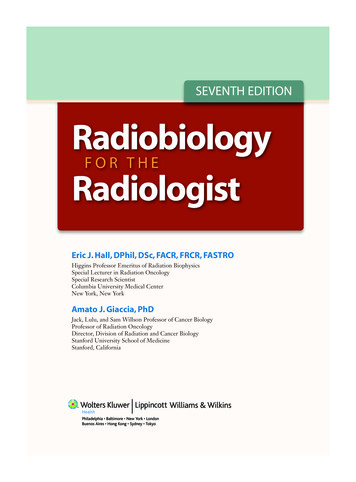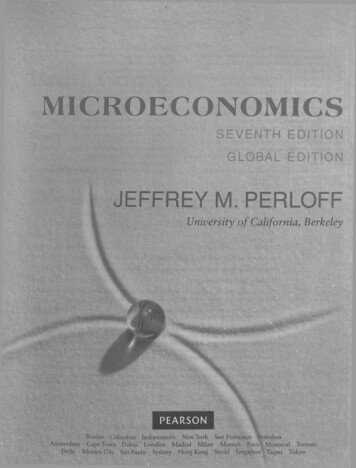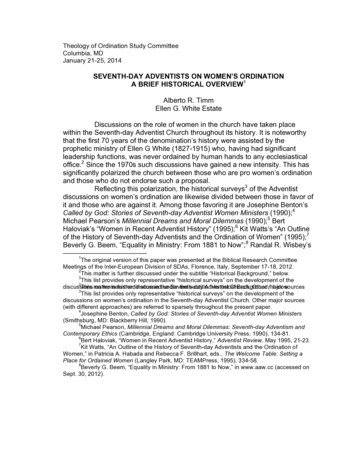
Transcription
SEVENTH EDITIONRadiobiologyFOR THERadiologistEric J. Hall, DPhil, DSc, FACR, FRCR, FASTROHiggins Professor Emeritus of Radiation BiophysicsSpecial Lecturer in Radiation OncologySpecial Research ScientistColumbia University Medical CenterNew York, New YorkAmato J. Giaccia, PhDJack, Lulu, and Sam Willson Professor of Cancer BiologyProfessor of Radiation OncologyDirector, Division of Radiation and Cancer BiologyStanford University School of MedicineStanford, California25858 Hall FM.indd i3/11/11 4:34 AM
Acquisitions Editor: Charles W. MitchellProduct Manager: Ryan ShawVendor Manager: Bridgett DoughertySenior Manufacturing Manager: Benjamin RiveraSenior Marketing Manager: Angela PanettaDesign Coordinator: Stephen DrudingProduction Service: Absolute Service, Inc./Maryland Composition 2012 by LIPPINCOTT WILLIAMS & WILKINS, a WOLTERS KLUWER businessTwo Commerce Square2001 Market StreetPhiladelphia, PA 19103 USALWW.comAll rights reserved. This book is protected by copyright. No part of this book may be reproduced inany form by any means, including photocopying, or utilized by any information storage and retrievalsystem without written permission from the copyright owner, except for brief quotations embodied incritical articles and reviews. Materials appearing in this book prepared by individuals as part of theirofficial duties as U.S. government employees are not covered by the above-mentioned copyright.Printed in ChinaLibrary of Congress Cataloging-in-Publication DataHall, Eric J.Radiobiology for the radiologist / Eric J. Hall, Amato J. Giaccia.—7th ed.p. ; cm.Includes bibliographical references and index.ISBN 978-1-60831-193-4 (hardback)1. Radiology, Medical. 2. Radiobiology. 3. Medical physics. I. Giaccia, Amato J. II. Title.[DNLM: 1. Radiation Effects. 2. Radiobiology. 3. Radiotherapy. WN 600]R895.H34 2012616.07'57—dc222011000060Care has been taken to confirm the accuracy of the information presented and to describe generallyaccepted practices. However, the authors, editors, and publisher are not responsible for errors oromissions or for any consequences from application of the information in this book and make nowarranty, expressed or implied, with respect to the currency, completeness, or accuracy of thecontents of the publication. Application of the information in a particular situation remains theprofessional responsibility of the practitioner.The authors, editors, and publisher have exerted every effort to ensure that drug selection anddosage set forth in this text are in accordance with current recommendations and practice at thetime of publication. However, in view of ongoing research, changes in government regulations,and the constant flow of information relating to drug therapy and drug reactions, the reader isurged to check the package insert for each drug for any change in indications and dosage and foradded warnings and precautions. This is particularly important when the recommended agent is anew or infrequently employed drug.Some drugs and medical devices presented in the publication have Food and Drug Administration(FDA) clearance for limited use in restricted research settings. It is the responsibility of the health careprovider to ascertain the FDA status of each drug or device planned for use in their clinical practice.To purchase additional copies of this book, call our customer service department at (800) 6383030 or fax orders to (301) 223-2320. International customers should call (301) 223-2300.Visit Lippincott Williams & Wilkins on the Internet: at LWW.com. Lippincott Williams &Wilkins customer service representatives are available from 8:30 am to 6:00 pm, EST.10 9 8 7 6 5 4 3 2 125858 Hall FM.indd ii3/11/11 4:34 AM
ContentsPreface to the First EditionPrefacevviiAcknowledgmentsixSection I: For Students of Diagnostic Radiology, Nuclear Medicine, and Radiation Oncology1Physics and Chemistry of Radiation Absorption2Molecular Mechanisms of DNA and ChromosomeDamage and Repair123Cell Survival Curves354Radiosensitivity and Cell Age in the Mitotic Cycle545Fractionated Radiation and the Dose-Rate Effect676Oxygen Effect and Reoxygenation867Linear Energy Transfer and Relative BiologicEffectiveness1048Acute Radiation Syndrome1149Radioprotectors12910Radiation Carcinogenesis13511Heritable Effects of Radiation15912Effects of Radiation on the Embryo and Fetus17413Radiation Cataractogenesis18814Radiologic Terrorism19315Molecular Imaging20116Doses and Risks in Diagnostic Radiology, Interventional Radiologyand Cardiology, and Nuclear Medicine222Radiation Protection253173Section II: For Students of Radiation Oncology18Cancer Biology27319Dose–Response Relationships for Model Normal Tissues30320Clinical Response of Normal Tissues32721Model Tumor Systems35622Cell, Tissue, and Tumor Kinetics37223Time, Dose, and Fractionation in Radiotherapy39124Retreatment after Radiotherapy: The Possibilitiesand the Perils412iii25858 Hall FM.indd iii3/11/11 4:34 AM
iv Contents 25Alternative Radiation Modalities41926The Biology and Exploitation of Tumor Hypoxia43227Chemotherapeutic Agents from the Perspectiveof the Radiation 858 Hall FM.indd iv3/11/11 4:34 AM
Preface to theFirst EditionThis book, like so many before it, grew out of aset of lecture notes. The lectures were given during the autumn months of 1969, 1970, and 1971at the Columbia-Presbyterian Medical Center,New York City. The audience consisted primarilyof radiology residents from Columbia, affiliatedschools and hospitals, and various other institutions in and around the city.To plan a course in radiobiology involvesa choice between, on the one hand, dealing atlength and in depth with those few areas of thesubject in which one has personal expertise as anexperimenter or, on the other hand, surveying thewhole field of interest to the radiologist, necessarily in less depth. The former course is very muchsimpler for the lecturer and in many ways moresatisfying; it is, however, of very little use to theaspiring radiologist who, if this course is followed,learns too much about too little and fails to getan overall picture of radiobiology. Consequently,I opted in the original lectures, and now in thisbook, to cover the whole field of radiobiology as itpertains to radiology. I have endeavored to avoidbecoming evangelical over those areas of thesubject which interest me, those to which I havedevoted a great deal of my life. At the same time Ihave attempted to cover, with as much enthusiasmas I could muster and from as much knowledge asI could glean, those areas in which I had no particular expertise or personal experience.This book, then, was conceived and written forthe radiologist—specifically, the radiologist who,motivated ideally by an inquiring mind or more realistically by the need to pass an examination, electsto study the biological foundations of radiology. Itmay incidentally serve also as a text for graduatestudents in the life sciences or even as a review ofradiobiology for active researchers whose viewpointhas been restricted to their own area of interest. Ifthe book serves these functions, too, the author isdoubly happy, but first and foremost, it is intendedas a didactic text for the student of radiology.Radiology is not a homogenous discipline.The diagnostician and therapist have divergentinterests; indeed, it sometimes seems that theycome together only when history and convenience dictate that they share a common coursein physics or radiobiology. The bulk of this bookwill be of concern, and hopefully of interest, to allradiologists. The diagnostic radiologist is commended particularly to Chapters 11, 12, and 13concerning radiation accidents, late effects, andthe irradiation of the embryo and fetus. A fewchapters, particularly Chapters 8, 9, 15, and 16,are so specifically oriented towards radiotherapythat the diagnostician may omit them withoutloss of continuity.A word concerning reference material is inorder. The ideas contained in this book represent, in the author’s estimate, the consensus ofopinion as expressed in the scientific literature.For ease of reading, the text has not been broken up with a large number of direct references.Instead, a selection of general references hasbeen included at the end of each chapter for thereader who wishes to pursue the subject further.I wish to record the lasting debt that I owemy former colleagues at Oxford and my presentcolleagues at Columbia, for it is in the daily cutand thrust of debate and discussion that ideas areformulated and views tested.Finally, I would like to thank the young menand women who have regularly attended myclasses. Their inquiring minds have forced meto study hard and reflect carefully before facingthem in a lecture room. As each group of students has grown in maturity and understanding,I have experienced a teacher’s satisfaction and joyin the belief that their growth was due in somesmall measure to my efforts.E. J. H.New YorkJuly 1972v25858 Hall FM.indd v3/11/11 4:34 AM
25858 Hall FM.indd vi3/11/11 4:34 AM
PrefaceThe seventh edition is the most radical revision of this textbook to date and now includescolor figures, a visual transformation over thesixth edition. However, we were careful to retain the same format as the sixth edition, whichdivided the book into two parts. Part I contains17 chapters and represents both a general introduction to radiation biology and a completeself-contained course in the subject, suitable forresidents in diagnostic radiology and nuclearmedicine. It follows the format of the Syllabus inRadiation Biology prepared by the RadiologicalSociety of North America (RSNA), and its content reflects the questions appearing in recentyears in the written examination for diagnosticradiology residents given by the American Boardof Radiology. Part II consists of 11 chapters ofmore in-depth material designed primarily forresidents in radiation oncology.We live in an exciting time, but yet a dangerous time as well. The threat of nuclear terrorrears its head way too often. If such an event occurs, those trained in the radiation sciences willbe called on to manage exposed individuals. Forthis reason, we have included a new chapter onRadiologic Terrorism (Chapter 14).The translation of molecular imaging intothe clinic is moving at a rapid pace. Therefore,we also included a chapter on fundamental concepts in molecular imaging that involves ionizingradiation such as CAT scans and PET imagingto reflect these new advances and describe theunderlying biologic principles for each of thesetechnologies (Chapter 15).The subject of retreatment with radiotherapyis not covered in most textbooks, and, becauseof this void, we have dedicated a new chapter tothis subject (Chapter 24). Recent clinical trialshave demonstrated a clinical benefit with hyperthermia, fulfilling the promise of this form oftherapy. These recent clinical studies have beenincluded in a thorough revision of this chapter(Chapter 28). Most of the other chapters in thisedition have also been revised and updated toreflect current thoughts and ideas.With the addition of the new chapters, some ofthe old chapters from the sixth edition have beeneliminated. For some time, we considered omitting the chapters on gene therapy and predictiveassays because these areas have yet to justify theirearly promise. In the end, they did not make thecut for the seventh edition. A separate chapteron “Molecular Techniques in Radiobiology”has also been eliminated because we felt thatwe could incorporate the fundamentals of thesemolecular techniques into the description of thedata where applicable throughout the book, andthe relevance of this chapter to the diagnostic ortherapeutic radiologist is questionable.The ideas contained in this book represent,we believe, the consensus of opinion as expressedin the scientific literature. We have followedthe precedent of previous editions, in that, thepages of text are unencumbered with flyspecklike numerals referring to footnotes or originalpublications, which are often too detailed to beof much interest to the general reader. On theother hand, there is an extensive and comprehensive bibliography at the end of each chapterfor those readers who wish to pursue the subjectfurther.We commend this new edition to residentsin radiology, nuclear medicine, and radiation oncology, for whom it was conceived and written.If it serves also as a text for graduate studentsin the life sciences or even as a review of basicscience for active researchers or senior radiationoncologists, the authors will be doubly happy.Eric J. HallColumbia University, New YorkAmato J. GiacciaStanford University, CaliforniaOctober 2010vii25858 Hall FM.indd vii3/11/11 4:34 AM
25858 Hall FM.indd viii3/11/11 4:34 AM
AcknowledgmentsWe would like to thank the many friends andcolleagues who generously and willingly gavepermission for diagrams and illustrations fromtheir published work to be reproduced in thisbook.Although the ultimate responsibility for thecontent of this book must be ours, we acknowledge with gratitude the help of several friendswho read chapters relating to their own areas ofexpertise and made invaluable suggestions andadditions. With each successive edition, this listgrows longer and now includes Drs. Ged Adams,Philip Alderson, Sally Amundson, Joel Bedford,Roger Berry, Max Boone, Victor Bond, DavidBrenner, J. Martin Brown, Ed Bump, DeniseChan, Julie Choi, James Cox, Nicholas Denko,Bill Dewey, Mark Dewhirst, Frank Ellis, PeterEsser, Stan Field, Greg Freyer, Charles Geard,Eugene Gerner, Julian Gibbs, George Hahn,Simon Hall, Ester Hammond, Tom Hei, RobertKallman, Richard Kolesnick, Adam Krieg,Dennis Leeper, Howard Lieberman, Philip Lorio,Edmund Malaise, Gillies McKenna, MortimerMendelsohn, George Merriam, Noelle Metting,Jim Mitchell, Anthony Nias, Ray Oliver, StanleyOrder, Tej Pandita, Marianne Powell, SimonPowell, Julian Preston, Elaine Ron, HaraldRossi, Robert Rugh, Chang Song, Fiona Stewart,Robert Sutherland, Roy Tishler, Len Tolmach, LizTravis, Lou Wagner, John Ward, Barry Winston,Rod Withers, and Basil Worgul. Of particularnote are Dr. Ted Graves, who was instrumentalin the development of Chapter 14 on molecularimaging, and Dr. Elizabeth Repasky, who revisedChapter 28 on hyperthermia. Without their help,this volume would be much the poorer.The principal credit for this book must goto the successive classes of residents in radiology, radiation oncology, and nuclear medicinethat we have taught over the years at Columbiaand Stanford, as well as at ASTRO and RSNArefresher courses. Their perceptive minds andsearching questions have kept us on our toes.Their impatience to learn what was needed ofradiobiology and to get on with being doctorshas continually prompted us to summarize andget to the point.We are deeply indebted to the U.S. Department of Energy, the National Cancer Institute,and the National Aeronautical and Space Administration, which have generously supportedour work and, indeed, much of the researchperformed by numerous investigators that isdescribed in this book.We owe an enormous debt of gratitude to Ms.Sharon Clarke, who not only typed and formatted the chapter revisions, but also played a majorrole in editing and proofreading. Our publisher,Ryan Shaw, guided our efforts at every stage andarranged for many of the figures to be updated.Finally, we thank our wives, Bernice Halland Jeanne Giaccia, who have been most patientand have given us every encouragement withthis work.ix25858 Hall FM.indd ix3/11/11 4:34 AM
25858 Hall FM.indd x3/11/11 4:34 AM
SECTIONIFor Students of DiagnosticRadiology, Nuclear Medicine, andRadiation Oncology25858 Hall CH01.indd 13/11/11 3:59 AM
25858 Hall CH01.indd 23/11/11 3:59 AM
CHAPTER1Physics and Chemistry ofRadiation AbsorptionTypes of Ionizing RadiationsElectromagnetic RadiationsParticulate RadiationsAbsorption of X-raysDirect and Indirect Action of RadiationAbsorption of Neutrons, Protons, and Heavy IonsSummary of Pertinent ConclusionsBibliographyIn 1895, the German physicist Wilhelm ConradRöntgen discovered “a new kind of ray,” emitted by a gas discharge tube, that could blackenphotographic film contained in light-tight containers. He called these rays “x-rays” in his firstannouncement in December 1895—the x representing the unknown. In demonstrating theproperties of x-rays at a public lecture, Röntgenasked Rudolf Albert von Kölliker, a prominentSwiss professor of anatomy, to put his hand inthe beam and so produced the first publicly takenradiograph (Fig. 1.1).The first medical use of x-rays was reportedin the Lancet of January 23, 1896. In this report,x-rays were used to locate a piece of a knife inthe backbone of a drunken sailor, who was paralyzed until the fragment was removed followingits location. The new technology spread rapidlythrough Europe and the United States, and thefield of diagnostic radiology was born. There issome debate about who first used x-rays therapeutically, but by 1896, Leopold Freund, an Austrian surgeon, demonstrated before the ViennaMedical Society the disappearance of a hairymole following treatment with x-rays. AntoineHenri Becquerel discovered radioactivity emitted by uranium compounds in 1896, and 2 yearslater, Pierre and Marie Curie isolated the radioactive elements polonium and radium. Within afew years, radium was used for the treatment ofcancer.The first recorded biologic effect of radiation was due to Becquerel, who inadvertentlyleft a radium container in his vest pocket. Hesubsequently described the skin erythema thatappeared 2 weeks later and the ulceration thatdeveloped and that required several weeks toheal. It is said that Pierre Curie repeated thisexperience in 1901 by deliberately producing aradium “burn” on his own forearm (Fig. 1.2).From these early beginnings, at the turn of thecentury, the study of radiobiology began.Radiobiology is the study of the action ofionizing radiations on living things. As such, itinevitably involves a certain amount of radiation physics. The purpose of this chapter is topresent, in summary form and with a minimumof mathematics, a listing of the various typesof ionizing radiations and a description of thephysics and chemistry of the processes by whichradiation is absorbed. TYPES OF IONIZING RADIATIONSThe absorption of energy from radiation inbiologic material may lead to excitation or toionization. The raising of an electron in an atomor molecule to a higher energy level without actual ejection of the electron is called excitation.If the radiation has sufficient energy to eject oneor more orbital electrons from the atom or molecule, the process is called ionization, and thatradiation is said to be ionizing radiation. Theimportant characteristic of ionizing radiation isthe localized release of large amounts of energy.The energy dissipated per ionizing event isabout 33 eV, which is more than enough to breaka strong chemical bond; for example, the energyassociated with a CBC bond is 4.9 eV. For convenience, it is usual to classify ionizing radiationsas either electromagnetic or particulate.Electromagnetic RadiationsMost experiments with biologic systems haveinvolved x- or -rays, two forms of electromagnetic radiation. X- and -rays do not differ in325858 Hall CH01.indd 33/11/11 3:59 AM
4 Section I For Students of Diagnostic Radiology, Nuclear Medicine, and Radiation Oncology F I GURE 1 . 1 The first publicly taken radiograph of aliving object, taken in January 1896, just a few monthsafter the discovery of x-rays. (Courtesy of RöntgenMuseum, Würzburg, Germany.)nature or in properties; the designation of x- or -rays reflects the ways they are produced.X-rays are produced extranuclearly; -raysare produced intranuclearly. In practical terms,this means that x-rays are produced in anelectrical device that accelerates electrons tohigh energy and then stops them abruptly in atarget usually made of tungsten or gold. Partof the kinetic energy (the energy of motion)of the electrons is converted to x-rays. On theother hand, -rays are emitted by radioactiveisotopes; they represent excess energy that isgiven off as the unstable nucleus breaks upand decays in its efforts to reach a stable form.Natural background radiation from rocks inthe earth also includes -rays. Everything thatis stated about x-rays in this chapter appliesequally well to -rays.X-rays may be considered from two different standpoints. First, they may be thought ofas waves of electrical and magnetic energy. Themagnetic and electrical fields, in planes at rightangles to each other, vary with time, so that thewave moves forward in much the same way asripples move over the surface of a pond if a stoneis dropped into the water. The wave moves witha velocity, c, which in a vacuum has a value of3 1010 cm/s. The distance between successivepeaks of the wave, , is known as the wavelength.The number of waves passing a fixed point persecond is the frequency, . The product of frequency times wavelength gives the velocity ofthe wave; that is, c.A helpful, if trivial, analogy is to liken thewavelength to the length of a person’s stridewhen walking; the number of strides per minute is the frequency. The product of the lengthof stride multiplied by the number of strides perminute gives the speed or velocity of the walker.F I GURE 1 . 2 Based on Becquerel’s earlier observation, Pierre Curie is said to haveused a radium tube to produce a radiationulcer on his arm. He charted its appearance and subsequent healing.25858 Hall CH01.indd 43/11/11 3:59 AM
Chapter 1 Physics and Chemistry of Radiation Absorption Like x-rays, radio waves, radar, radiant heat,and visible light are forms of electromagneticradiation. They all have the same velocity, c, butthey have different wavelengths and, therefore,different frequencies. To extend the previousanalogy, different radiations may be likenedto a group of people, some are tall, some areshort, all walking together at the same speed.The tall walkers take long measured strides butmake few strides per minute; to keep up, theshort walkers compensate for the shortness oftheir strides by increasing the frequencies oftheir strides. A radio wave may have a distancebetween successive peaks (i.e., wavelength) of300 m; for a wave of visible light, the corresponding distance is about 500 thousandths ofa centimeter (5 10 5 cm). The wavelengthfor x-rays may be 100 millionths of a centimeter (10 8 cm). X- and -rays, then, occupy theshort-wavelength end of the electromagneticspectrum (Fig. 1.3).Second, x-rays may be thought of asstreams of photons, or “packets” of energy.Each energy packet contains an amount of energy equal to h , where h is known as Planck’sconstant and is the frequency. If a radiationhas a long wavelength, it has a small frequency,and so, the energy per photon is small. Conversely, if a given radiation has a short wavelength, the frequency is large and the energyper photon is large. There is a simple numeric relationship between the photon energyF I GURE 1 . 3 Illustration of the electromagneticspectrum. X-rays and -rays have the same natureas visible light, radiant heat, and radio waves; however, they have shorter wavelengths and consequently, a larger photon energy. As a result, x- and -rays can break chemical bonds and produce biologiceffects.25858 Hall CH01.indd 55(in kiloelectron volts*) and the wavelength(in angstroms†): Å 12.4/E(keV)For example, x-rays with wavelengths of 0.1 Åcorrespond to a photon energy of 124 keV.The concept of x-rays being composed ofphotons is very important in radiobiology. Ifx-rays are absorbed in living material, energy isdeposited in the tissues and cells. This energy isdeposited unevenly in discrete packets. The energy in a beam of x-rays is quantized into largeindividual packets, each of which is big enough tobreak a chemical bond and initiate the chain ofevents that culminates in a biologic change. Thecritical difference between nonionizing and ionizing radiations is the size of the individual packetsof energy, not the total energy involved. A simplecalculation illustrates this point. It is shown inChapter 8 that a total body dose of about 4 Gy‡of x-rays given to a human is lethal in about halfof the individuals exposed. This dose representsabsorption of energy of only about 67 cal, assuming the person to be a “standard man” weighing70 kg. The smallness of the amount of energy involved can be illustrated in many ways. Convertedto heat, it would represent a temperature rise of0.002 C, which would do no harm at all; the sameamount of energy in the form of heat is absorbedin drinking one sip of warm coffee. Alternatively,the energy inherent in a lethal dose of x-rays maybe compared with mechanical energy or work. Itwould correspond to the work done in lifting aperson about 16 in. from the ground (Fig. 1.4).Energy in the form of heat or mechanicalenergy is absorbed uniformly and evenly, andmuch greater quantities of energy in these formsare required to produce damage in living things.The potency of x-rays, then, is a function not*The kiloelectron volt (keV) is a unit of energy. It is theenergy possessed by an electron that has been acceleratedthrough 1,000 volts (V). It corresponds to 1.6 10 9 ergs.†The angstrom (Å) is a unit of length equal to 10 8 cm.‡Quantity of radiation is expressed in röntgen, rad, or gray.The röntgen (R) is the unit of exposure and is related to theability of x-rays to ionize air. The rad is the unit of absorbeddose and corresponds to energy absorption of 100 erg/g.In the case of x- and -rays, an exposure of 1 R results inan absorbed dose in water or soft tissue roughly equal to 1rad. The International Commission on Radiological Units andMeasurements (ICRU) recommended that the rad be replacedas a unit by the gray (Gy), which corresponds to an energyabsorption of 1 J/kg. Consequently, 1 Gy 100 rad.3/11/11 3:59 AM
6 Section I For Students of Diagnostic Radiology, Nuclear Medicine, and Radiation Oncology F I GURE 1 . 4 The biologic effect of radiation is determined not by the amount of the energy absorbedbut by the photon size, or packet size, of the energy.A: The total amount of energy absorbed in a 70-kghuman exposed to a lethal dose of 4 Gy is only 67 cal.B: This is equal to the energy absorbed in drinking onesip of warm coffee. C: It also equals the potential energy imparted by lifting a person about 16 in.so much of the total energy absorbed as of thesize of the individual energy packets. In theirbiologic effects, electromagnetic radiations areusually considered ionizing if they have a photonenergy in excess of 124 eV, which corresponds toa wavelength shorter than about 10 6 cm.Particulate RadiationsOther types of radiation that occur in natureand that are also used experimentally are electrons, protons, -particles, neutrons, negative -mesons, and heavy charged ions. Some also are25858 Hall CH01.indd 6used in radiation therapy and have a potential indiagnostic radiology not yet explored.Electrons are small, negatively charged particles that can be accelerated to high energy to aspeed close to that of light by means of an electrical device, such as a betatron or linear accelerator. They are widely used for cancer therapy.Protons are positively charged particles andare relatively massive, having a mass almost 2,000times greater than that of an electron. Because oftheir mass, they require more complex and moreexpensive equipment, such as a cyclotron, to accelerate them to useful energies, but they are increasingly used for cancer treatment in specializedcenters because of their favorable dose distribution (see Chapter 25).In nature, the earth is showered with protons from the sun, which represent a componentof natural background radiation. We are protected on earth to a large extent by the earth’satmosphere. In addition, the earth behaves likea giant magnet so that charged particles fromsolar events on the sun are deflected away fromthe equator by the earth’s magnetic field; mostmiss the earth altogether while others are funneled into the polar regions. This is the basis ofthe “aurora borealis,” or northern lights causedby intense showers of charged particles that spiraldown the lines of magnetic field into the poles,ionizing the air as they do so (see Chapter 16).Protons are a major hazard to astronauts on longduration space missions. -particles are nuclei of helium atoms andconsist of two protons and two neutrons in closeassociation. They have a net positive charge and,therefore, can be accelerated in large electricaldevices similar to those used for protons. -particles are also emitted during the decayof heavy, naturally occurring radionuclides, suchas uranium and radium (Fig. 1.5). -particles arethe major source of natural background radiation to the general public. Radon gas seeps outof the soil and builds up inside houses, where,together with its decay products, it is breathedin and irradiates the lining of the lung. It is estimated that 10,000 to 20,000 cases of lung cancerare caused each year by this means in the UnitedStates, mostly in smokers.Neutrons are particles with a mass similar to that of protons, but they carry no electrical charge. Because they are electrically neutral,they cannot be accelerated in an electrical device.3/11/11 3:59 AM
Chapter 1 Physics and Chemistry of Radiation Absorption 7FIG U R E 1. 5 Illustration of the decayof a heavy radionuclide by the emission ofan -particle. An -particle is a helium nucleus consisting of two protons and twoneutrons. The emission of an -particle decreases the atomic number by 2 and themass number by 4. Note that radium haschanged to another chemical element,radon, as a consequence of the decay.They are produced if a charged particle is accelerated to high energy and then made to impinge ona suitable target material. Neutrons are also emitted as a by-product if heavy radioactive atoms undergo fission; that i
residents in diagnostic radiology and nuclear medicine. It follows the format of the Syllabus in Radiation Biology prepared by the Radiological Society of North America (RSNA), and its con-tent refl ects the questions appearing in recent years in the written examination for diagnostic radi










